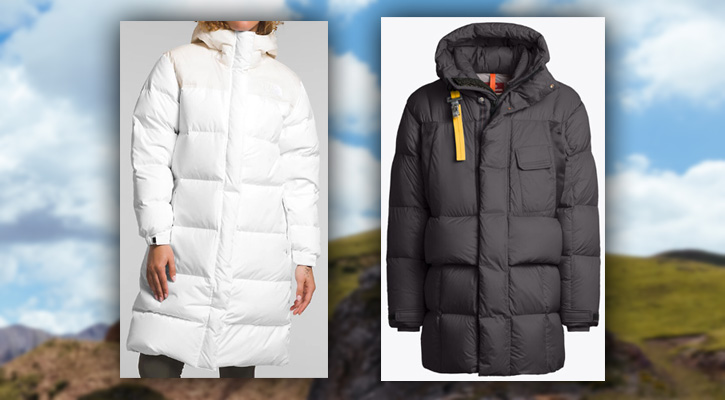
Parajumpers and The North Face are two iconic outerwear brands renowned for their functional and fashionable winter jackets and parkas.
Both have a rich history of innovation and dedication to protecting their customers from extreme cold.
While Parajumpers is renowned for its premium down insulation and resilience against cold weather, The North Face is celebrated for its versatile technical designs optimized for outdoor activities and sports.
Here we’ll compare these brands by examining their materials, features, warmth, and value to determine which may be the better one depending on needs and budget.
Contents:
1. Parajumpers Jackets
History of the Brand
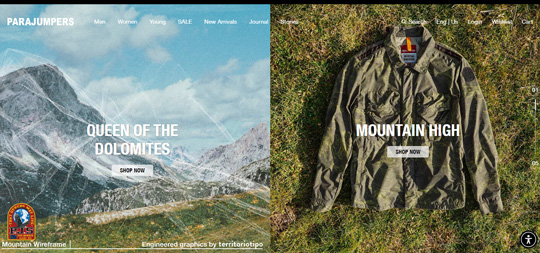
Parajumpers official website
A modern Italian label founded in 2006, Parajumpers creates exceptional outerwear that transcends mere functionality. Their designs embody both style and substance, reflecting the remarkable origins of the brand.
The fortuitous encounter in Anchorage, Alaska, between Massimo Rossetti, the brand’s designer, and a member of the 210th Rescue Squadron, serves as a testament to the brand’s unique inspiration. The 210th Rescue Squadron, composed of expert parachutists, provided the name for Parajumpers.
This elite military unit specializes in high-stakes rescue missions, intervening in challenging operations to save lives in remote mountainous or maritime environments.
Influenced by their work, Massimo Rossetti embarked on creating exceptionally functional jackets, crafted from resilient nylon to endure the most extreme conditions, serving as more than just outerwear.
Like Massimo, we admire this brand’s origins and love the practicality of their designs, some of which will be highlighted in this comparison.
Don’t miss: 7 Best Italian Down Jacket Brands for Winter
Materials, Fabrics, and Production Process
As previously stated, Parajumpers utilizes durable nylon fabric, and their materials are sourced from the Far East, including countries like China, Korea, and Japan, as well as Italy. All materials follow rigorous standards to ensure compliance with safety regulations and the absence of harmful substances.
In addition to functional and comfortable designs, the brand’s high-quality natural down provides exceptional insulation without excessive bulk. Some designs feature removable down-filled linings, offering versatility for varying weather conditions.
Some of the brand’s winter jackets feature natural fur that adheres to stringent farming regulations, ensuring the humane treatment of animals. For those averse to animal-based products, Parajumpers also offers synthetic alternatives.
While design takes place in Italy, manufacturing occurs in the Far East, with select collections produced in Europe, all subject to strict quality and ethical standards.
The video will be loaded from YouTube.com, a third party. If you play it, you accept their terms of service, and their use of cookies.
Read also: Parajumpers vs Woolrich: Which Brand is Better?
Recommended Products
Parajumpers Men’s Bold Parka
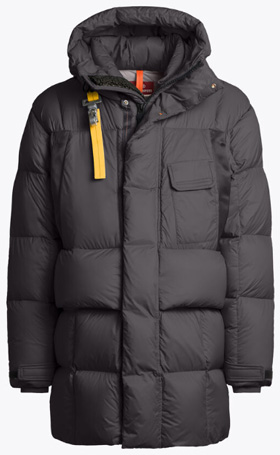
Image: parajumpers.it
Check it out at Parajumpers.it
The Parajumpers Men’s Bold Parka is a highly resilient and cozy puffer coat crafted for severe cold, ranked at the top temperature level by the brand. It includes a modifiable hood with a fleece-lined collar, a two-way zipper with a storm flap, and a range of pockets such as hand-warmer pockets and internal storage pockets.
In addition, the parka features a waist powder skirt, underarm vents, and Velcro sleeve straps to combat the elements. It’s constructed from water-repellent nylon Cordura ripstop and insulated with a 90-10 down-feather blend and integrates 20% recycled materials.
Design elements include the brand’s distinctive yellow hook and patch, contributing to its fashionable appeal while ensuring functionality and warmth during the winter season.
Read also: Parajumpers vs Moncler: Which Brand is Better?
Parajumpers Women’s Panda Long Puffer Coat
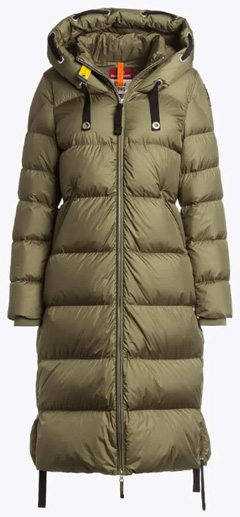
Image: parajumpers.it
Check it out at Parajumpers.it
The Women’s Panda Long Puffer Coat is crafted to provide warmth and protection in cold weather. It includes an adjustable hood and a two-way zipper for flexible closure. The coat has zippered pockets for secure storage, inner mesh pockets, and adjustable ribbed cuffs and hem for a snug fit.
Aesthetic details such as the brand’s signature yellow tape and patch enhance its distinctive style. The 15-denier nylon micro ripstop outer fabric is internally bonded with a water-repellent foil, making it water-repellent and windproof yet breathable.
Filled with 100% duck down with a fill power of 770, the coat offers significant warmth, and its downproof construction prevents down leakage. Also, 20% of the garment is made from recycled materials.
Don’t miss: Parajumpers vs Canada Goose: Which is Better?
Prices
Parajumpers is known for its premium pricing, with jacket prices ranging from $300 to $1,500 rivaling those of The North Face. The high cost reflects the exceptional quality of their products, attributed to the superior manufacturing and materials in their jackets and longer coats.
Are Parajumpers jackets worth the price?
Considering the superior quality of these jackets and their focus on functionality, many of you will find them a good investment. And we think so too. However, some of their expensive models do not offer the highest warmth, and this could be a potential concern for buyers who need exceptionally warm parkas.
Learn more: 10 Best Expensive and Luxury Winter Jacket Brands
2. The North Face Jackets
History of the Brand
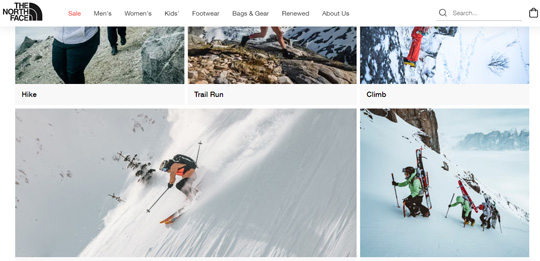
The North Face’s official website
The North Face has established itself as a famous American brand in the outdoor clothing and equipment industry, earning a dedicated following since its establishment in 1966.
Initially focusing on building technical mountain gear such as hiking packs, tents, and skiwear, the brand expanded its appeal beyond outdoor enthusiasts in the 1990s, attracting attention from celebrities. A rapper featured the Steep Tech jacket in a music video in 1993, for example.
The brand’s name originates from the coldest and most difficult to climb side of a mountain in the northern hemisphere, known as ‘the north face.’
Don’t miss:
11 Brands like The North Face: Our Top Alternatives
12 Best American Jackets and Outdoor Clothing Brands
Materials, Fabrics, and Production Process
The North Face uses mostly Nylon and Polyester, common materials among outdoor gear brands including Parajumpers, and integrates various technologies into its products.
One notable innovation is the FUTURELIGHT membrane, which has a thin nanomembrane allowing airflow while repelling water. Extensively tested, it demonstrates exceptional waterproofing even in severe outdoor conditions.
Additionally, the brand incorporates goose down for thermal insulation, ensuring customers’ comfort and warmth during extended journeys. This lightweight insulation enables unrestricted movement during challenging activities.
The North Face also incorporates renowned technologies such as the standard Gore-Tex, providing waterproof, windproof, and breathable properties. You probably already know that Gore-Tex effectively manages sweat moisture while repelling water.
Also, the brand has developed additional technologies including DryVent, WindWall, FlashDry, and the popular ThermoBall synthetic insulation which imitates natural down.
The video will be loaded from YouTube.com, a third party. If you play it, you accept their terms of service, and their use of cookies.
Read also:
The North Face vs Helly Hansen Outdoor Gear: A Comparison
Moncler vs North Face: Which is Better for Jackets?
Where are The North Face jackets made?
The majority of The North Face outdoor apparel and jackets are produced in Asian nations like China, India, Bangladesh, and Vietnam, with additional collections manufactured in the USA.
Recommended Products
The North Face Men’s McMurdo Parka
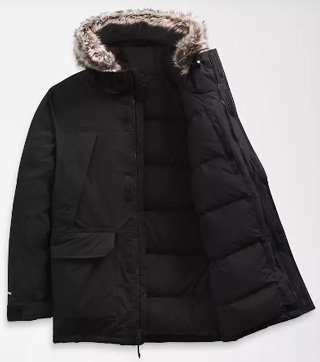
Image: thenorthface.com
Check it out at TheNorthFace.com
The Men’s McMurdo Parka has been crafted to deliver warmth and defense against the elements and wind. With a relaxed fit and 600-fill recycled waterfowl down insulation, this coat is an excellent option for cold conditions.
Its seam-sealed DryVent™ 2L shell, complete with a non-PFC DWR finish, provides windproof, waterproof, and breathable capabilities. The parka boasts practical elements such as zip chest pockets, two dual-entry front patch pockets, and a secure-zip internal chest pocket.
Additionally, it features an attached, three-piece hood with an internal drawcord for adjustability and a detachable faux-fur ruff, along with a storm flap covering the two-way front zip. The parka also has an embroidered logo on the left chest and back-right shoulder, adding a stylish touch to it.
Adjustable cuff tabs ensure a secure and comfortable fit, making the McMurdo a versatile choice for protecting you in severe weather.
Read also: The North Face Diablo vs. Nuptse: Which Jacket is Better?
The North Face Women’s Nuptse Parka
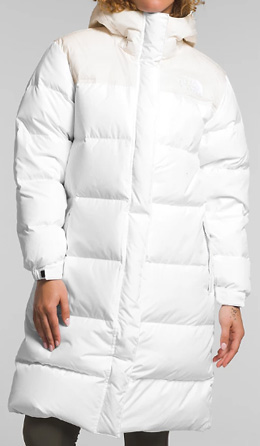
Image: thenorthface.com
Check it out at TheNorthFace.com
The Women’s Nuptse Parka by The North Face presents a modern interpretation of the classic 1996 Nuptse Jacket. It’s built with a relaxed fit and an extended parka length to provide additional coverage. The coat incorporates 700-fill recycled down insulation for warmth and environmental sustainability.
To enhance durability, a ripstop overlay is featured on the hood and yoke, while a non-PFC DWR finish ensures water repellency without the use of harmful chemicals. Practical elements such as an attached hood with an adjustable drawcord, a storm flap over the front zip, and hand pockets contribute to its functionality.
Also, adjustable cuffs offer a snug fit, and The North Face’s embroidered logo adds a touch of brand heritage.
Don’t miss: The North Face Diablo vs Himalayan: Which is Better?
Prices
The prices of The North Face’s items tend to be higher compared to numerous other outdoor equipment brands. But in general, the brand falls in the mid-to-high price range. For example, their jackets and coats range from around $70 for lighter styles to $800 for highly-insulated winter options.
Are The North Face jackets worth the price?
If you are a serious mountain hiker, skier, or explorer, The North Face jackets can justify their cost. They’re built to deliver the comfort, utility, and effectiveness you need while up in the mountains.
When it comes to everyday wear, it depends. Because maybe you don’t need a highly technical jacket just for city wear.
Learn more: Why Is The North Face So Expensive and Popular? Are Its Jackets Worth It?
3. Which is Better? Parajumpers or The North Face?
We find Parajumpers to be higher-end and more luxury-level, but both are great for their respective markets. Here’s what we think of these brands to help you decide:
- Parajumpers specializes in extreme cold weather outerwear and is known for its down jackets. It uses premium materials and has very warm and durable designs meant for the coldest environments. Parajumpers jackets are usually more expensive.
- The North Face is a well-known outdoor recreation brand. Their jackets come in a wider range of styles for different types of weather and outdoor activities. The North Face has both innovative technical jackets as well as more casual designs. Their prices are generally more affordable than those of Parajumpers.
- For severe cold like arctic expeditions or mountaineering, Parajumpers may provide better protection and insulation with some of its designs.
- For more general winter use and activities like skiing, snowboarding, hiking, or daily winter wear, The North Face provides great quality and value. Their jackets offer good warmth balanced with features and style.
So, in the end, Parajumpers has good options for very low temperatures, while The North Face is more versatile offering a wider range of technical features and protection levels. The final decision will depend on your needs and budget.
Read next: 10 European Down and Puffer Jacket Brands for Winter
